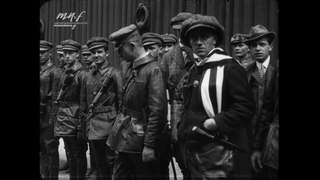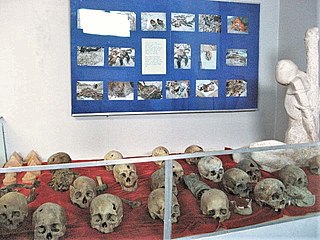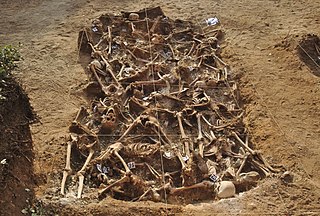 W
WThe Bodo League massacre was a massacre and war crime against communists and suspected sympathizers that occurred in the summer of 1950 during the Korean War. Estimates of the death toll vary. Historians and experts on the Korean War estimate that the full total ranges from at least 60,000–110,000 to 200,000. The massacre was wrongly blamed on the communists. The South Korean government made efforts to conceal this massacre for four decades. Survivors were forbidden by the government from revealing it, under suspicion of being communist sympathizers; public revelation carried with it the threat of torture and death. During the 1990s and onwards, several corpses were excavated from mass graves, resulting in public awareness of the massacre.
 W
WThe Butovo Firing Range or Butovo Shooting Range was an execution site of the Soviet secret police located near Drozhzhino in Leninsky District, Moscow Oblast from 1938 to 1953.
 W
WThe Cambodian genocide was the systematic persecution and killing of Cambodians by the Khmer Rouge under the leadership of Communist Party general secretary Pol Pot, who radically pushed Cambodia towards communism. It resulted in the deaths of 1.5 to 2 million people from 1975 to 1979, nearly a quarter of Cambodia's 1975 population.
 W
WThe Cultural Revolution, formally the Great Proletarian Cultural Revolution, was a violent sociopolitical purge movement in China from 1966 until Mao Zedong's death in 1976. Launched by Mao Zedong, Chairman of the Chinese Communist Party (CCP) and founder of the People's Republic of China (PRC), its stated goal was to preserve Chinese communism by purging remnants of capitalist and traditional elements from Chinese society, and to re-impose Mao Zedong Thought as the dominant ideology in the PRC. The Revolution marked Mao's return to the central position of power in China after a period of less radical leadership to recover from the failures of the Great Leap Forward, which contributed to the Great Chinese Famine only five years prior.
 W
WThe East Timor genocide refers to the "pacification campaigns" of state terrorism which were waged by the Indonesian New Order government during the United States–backed Indonesian invasion and occupation of East Timor. Although some sources consider the Indonesian killings in East Timor to constitute genocide, other scholars disagree.
 W
WThe flight and expulsion of Germans from Poland was the largest of a series of flights and expulsions of Germans in Europe during and after World War II. The German population fled or was expelled from all regions which are currently within the territorial boundaries of Poland, including the former eastern territories of Germany and parts of pre-war Poland.
 W
WThe Great Leap Forward of the People's Republic of China (PRC) was an economic and social campaign led by the Chinese Communist Party (CCP) from 1958 to 1962. Chairman Mao Zedong launched the campaign to reconstruct the country from an agrarian economy into a communist society through the formation of people's communes. Mao decreed increased efforts to multiply grain yields and bring industry to the countryside. Local officials were fearful of Anti-Rightist Campaigns and competed to fulfill or over-fulfill quotas based on Mao's exaggerated claims, collecting "surpluses" that in fact did not exist and leaving farmers to starve. Higher officials did not dare to report the economic disaster caused by these policies, and national officials, blaming bad weather for the decline in food output, took little or no action. The Great Leap resulted in tens of millions of deaths, with estimates ranging between 15 and 55 million deaths, making the Great Chinese Famine the largest famine in human history.
 W
WThe Great Purge or the Great Terror, also known as the Year of '37 and the Yezhovschina, was Joseph Stalin's campaign of political repression in the Soviet Union that occurred from 1936 to 1938. It involved large-scale repression of the peasantry; ethnic cleansing; purges of the Communist Party, government officials, and the Red Army; widespread police surveillance, suspicion of saboteurs and counter-revolutionaries, imprisonment, and arbitrary executions. Historians estimate the total number of deaths due to Stalinist repression in 1937–38 to be between 950,000 and 1.2 million.
 W
WThe Indonesian mass killings of 1965–66 were large-scale killings and civil unrest that occurred in Indonesia over several months, targeting Communist Party of Indonesia (PKI) party members, Communist sympathisers, Gerwani women, ethnic Javanese Abangan, ethnic Chinese, and alleged leftists, often at the instigation of the armed forces and government, which were supported by the United States and other Western countries. It began as an anti-communist purge following a controversial attempted coup d'état by the 30 September Movement. The most widely published estimates were that 500,000 to more than one million people were killed, with some more recent estimates going as high as two to three million. The purge was a pivotal event in the transition to the "New Order" and the elimination of PKI as a political force, with impacts on the global Cold War. The upheavals led to the fall of President Sukarno and the commencement of Suharto's three-decade authoritarian presidency.
 W
WThe Indonesian occupation of East Timor began in December 1975 and lasted until October 1999. After centuries of Portuguese colonial rule in East Timor, a 1974 coup in Portugal led to the decolonisation of its former colonies, creating instability in East Timor and leaving its future uncertain. After a small-scale civil war, the pro-independence Fretilin declared victory in the capital city of Dili and declared an independent East Timor on 28 November 1975.
 W
WKommunarka shooting ground was an execution site of the NKVD located near Kommunarka, Moscow Oblast from 1937 to 1941.
 W
WThe Land Reform Movement, also known by the Chinese abbreviation Tǔgǎi (土改), was a campaign by the Communist Party leader Mao Zedong during the late phase of the Chinese Civil War and the early People's Republic of China. The campaign involved mass killings of landlords by tenants and land redistribution to the peasantry. The estimated amount of casualties of the movement ranges from hundreds of thousands to millions. In terms of the communist party's evaluation Zhou Enlai estimated 830,000 had been killed and Mao Zedong estimated as many as 2 to 3 million were killed.
 W
WThe Battle of Meligalas took place at Meligalas in Messenia in southwestern Greece, on 13–15 September 1944, between the Greek Resistance forces of the Greek People's Liberation Army (ELAS) and the collaborationist Security Battalions.
 W
WThe Night of the Long Knives, or the Röhm Purge, also called Operation Hummingbird, was a purge that took place in Nazi Germany from June 30 to July 2, 1934. Chancellor Adolf Hitler, urged on by Hermann Göring and Heinrich Himmler, ordered a series of political extrajudicial executions intended to consolidate his power and alleviate the concerns of the German military about the role of Ernst Röhm and the Sturmabteilung (SA), the Nazis' paramilitary organization, known colloquially as "Brownshirts." Nazi propaganda presented the murders as a preventive measure against an alleged imminent coup by the SA under Röhm – the so-called Röhm Putsch.
 W
WOperation Condor was a United States-backed campaign of political repression and state terror involving intelligence operations and assassination of opponents. It was officially and formally implemented in November 1975 by the right-wing dictatorships of the Southern Cone of South America.
 W
WThe Red Terror in Soviet Russia was a campaign of political repression and executions carried out by the Bolsheviks—chiefly through the Cheka, the Bolshevik secret police— started in late summer 1918 after the beginning of the Russian Civil War and lasted until 1922. Arising after an assassination attempt on Vladimir Lenin, the Red Terror was modeled on the Reign of Terror of the French Revolution, and sought to eliminate opposition, political dissent, and any other threat to Bolshevik power.
 W
WThe Red Terror in Hungary was a period of repressive violence and suppression in 1919 during the four-month period of the Hungarian Soviet Republic, primarily towards anti-communist forces, and others deemed "enemies of the state". According to Robin Okey, The communist party and communist policies had considerable popular support among the proletarian masses of large industrial centers - especially in Budapest - where the working class represented a higher ratio of the inhabitants. In the Hungarian countryside, according to John Lukacs, the authority of the government was often nonexistent, serving as a launch-point for anti-communist insurgency. The new government followed the Soviet method: the party established its revolutionary terror groups to "overcome the obstacles" of the "worker's revolution". It received its name in reference to the Red Terror of Soviet Russia. It was soon followed by the White Terror against communists, industrial workers and Jews.
 W
WThe Red Terror in Spain is the name given by historians to various acts of violence committed from 1936 until the end of the Spanish Civil War by sections of nearly all the leftist groups. News of the rightist military uprising in July 1936 allegedly unleashed a politicidal response, and no Republican controlled region escaped systematic and anticlerical violence, although it was minimal in the Basque Country. The violence consisted of the killing of tens of thousands of people, attacks on the Spanish nobility, business owners, industrialists, and politicians and supporters of the conservative parties, as well as the desecration and burning of monasteries, convents, and churches.
 W
WThe Reign of Terror, commonly called The Terror, was a period of the French Revolution when, following the creation of the First French Republic, a series of massacres and numerous public executions took place in response to revolutionary fervour, anticlerical sentiment, and accusations of treason by the Committee of Public Safety.
 W
WSandarmokh is a forest massif 12 kilometres (7.5 mi) from Medvezhyegorsk in the Republic of Karelia where thousands of victims of Stalin's Great Terror were executed. Over 9,000 people of more than 58 nationalities were shot and buried there in 236 communal pits over a 14-month period in 1937 and 1938.
 W
WThe Solovki special camp, was set up in 1923 on the Solovetsky Islands in the White Sea as a remote and inaccessible place of detention, primarily intended for socialist opponents of Soviet Russia's new Bolshevik regime. The first book on Gulag, namely, In the Claws of the GPU (1934) by Francišak Aljachnovič, described the Solovki prison camp.
 W
WThe Stalinist repressions in Mongolia refers to an 18 month period of heightened political violence and persecution in the Mongolian People's Republic between 1937 and 1939. The repressions were an extension of the Stalinist purges unfolding across the Soviet Union around the same time. Soviet NKVD advisors, under the nominal direction of Mongolia's de facto leader Khorloogiin Choibalsan, persecuted thousands of individuals and organizations perceived as threats to the Mongolian revolution and the growing Soviet influence in the country. As in the Soviet Union, methods of repression included torture, show trials, executions, and imprisonment in remote forced labor camps, often in Soviet gulags. Estimates differ, but anywhere between 20,000 and 35,000 "enemies of the revolution" were executed, a figure representing three to five percent of Mongolia's total population at the time. Victims included those accused of espousing Tibetan Buddhism, pan-Mongolist nationalism, and pro-Japanese sentiment. Buddhist clergy, aristocrats, intelligentsia, political dissidents, and ethnic Buryats and Kazakhs suffered the greatest losses.
 W
WThe War of Canudos was a conflict between the First Brazilian Republic and the residents of Canudos in the northeastern state of Bahia. After a number of unsuccessful attempts at military suppression, the conflict came to a brutal end in October 1897, when a large subsection of the Brazilian army overran the village, razed it and slaughtered nearly all its inhabitants. This conflict marks the deadliest civil war in Brazilian history.
 W
WIn the history of Spain, the White Terror describes the political repression, including executions and rapes, which were carried out by the Nationalist faction during the Spanish Civil War (1936–1939), as well as during the first nine years of the regime of General Francisco Franco. In the 1936–1945 period, Francoist Spain had many official enemies: Loyalists to the Second Spanish Republic (1931–1939), Liberals, socialists of different stripes, Protestants, atheists, intellectuals, homosexuals, Freemasons, Jews, Romanis, Basque, Catalan, Andalusian and Galician nationalists.